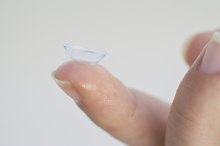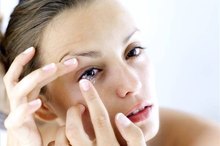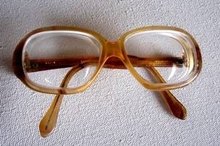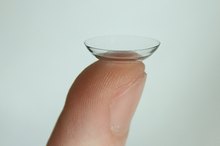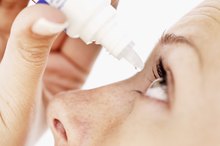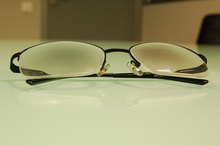The Ingredients in Contact Lens Cleaning Solution
Wearing contact lenses can be more comfortable if you clean them regularly. Visual acuity is better as well. Cleaning solutions help to remove dirt and protein deposits from the surface of the lens. There are many different multipurpose solutions available on the market that you can use to clean, disinfect and store contact lenses. However, the University of Michigan Kellogg Eye Center warns against mixing different brands of contact lens solutions as ingredients can vary 2.
Disinfectant
The Contact Lens Association of Ophthalmologists recommends cleaning and disinfecting contact lenses on a daily basis, as infection is the greatest risk to contact lens wearers. Although eye care specialists may suggest the use of different cleaning solutions for different lenses, hydrogen peroxide is often the main ingredient in many brands. Hydrogen peroxide disinfects lenses by killing bacteria and fungi.
Water is not recommended for cleaning lenses, as the use of water alone does not disinfect the lens. Neither tap water nor distilled water is sterile, and pose a serious risk of infection. A lens cleaned only with water can get contaminated, thereby increasing the risk of eye irritation or infection, which can lead to permanent damage to the eye.
- The Contact Lens Association of Ophthalmologists recommends cleaning and disinfecting contact lenses on a daily basis, as infection is the greatest risk to contact lens wearers.
Surfactant
What Does it Mean If Your Contacts Have White Spots on Them?
Learn More
A contact lens cleaning solution may contain a mild abrasive, as well as a detergent or surfactant to clean buildup on the surface of the lens without scratching it. Some cleaning solution products contain tiny silica gel abrasive particles. Removal of protein deposits is a particular concern as these can cause complications such as contact lens-induced papillary conjunctivitis, according to the New England College of Optometry 1. Enzymatic cleaners are typically recommended to wearers of soft contacts who have problems with protein films on their lenses.
- A contact lens cleaning solution may contain a mild abrasive, as well as a detergent or surfactant to clean buildup on the surface of the lens without scratching it.
Anti-Fungal and Anti-Bacterial Agents
Boric acid is the active ingredient contained in some brands of multipurpose contact lens cleaning solutions. Like hydrogen peroxide, boric acid is a disinfectant and anti-fungal agent used in contact lens solutions to prevent the growth of microorganisms on the eye. These sterile solutions are often preserved with ascorbic acid or edetate disodium. Ascorbic acid is an effective preservative for protecting against the growth of bacteria and fungi on contact lenses. Edetate disodium is another preservative used to stop the growth of microorganisms.
- Boric acid is the active ingredient contained in some brands of multipurpose contact lens cleaning solutions.
- Edetate disodium is another preservative used to stop the growth of microorganisms.
Related Articles
References
- New England College of Optometry: Contact Lens Solutions Update 2006
- University of Michigan Kellogg Eye Center: Eye Conditions
- CDC. Contact Lens Wearer Demographics and Risk Behaviors for Contact Lens-Related Eye Infections — United States, 2014 Published in CDCWeekly August 21, 2015.
Writer Bio
Amber Keefer has more than 25 years of experience working in the fields of human services and health care administration. Writing professionally since 1997, she has written articles covering business and finance, health, fitness, parenting and senior living issues for both print and online publications. Keefer holds a B.A. from Bloomsburg University of Pennsylvania and an M.B.A. in health care management from Baker College.
